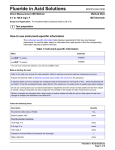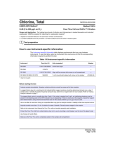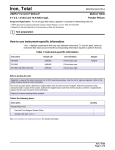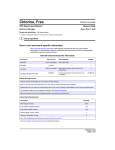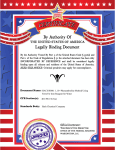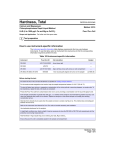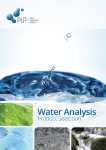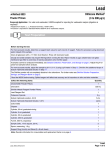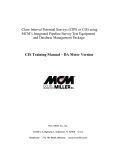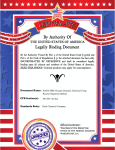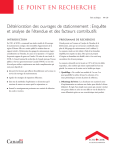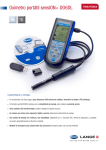Download Manual - Hach Nitrate and Nitrite Test Strips
Transcript
Nitrate, drinking water, 8359 Nitrate DOC316.53.01239 Direct Measurement ISE Method Method 8359 0.04 to 4.00 mg/L NO3–N TISAB Solution Scope and Application: Drinking water Test preparation How to use instrument-specific information The Instrument-specific information table displays requirements that may vary between instruments. To use this table, select an instrument then read across to find the corresponding information required to perform this test. Table 452 Instrument-specific information Meter sension™ 4 meters1 1 Electrode 5192000 Only sension 4 meters can be used for this analysis. Before starting the test: Refer to the meter user manual for meter operation. Refer to electrode manual for electrode maintenance and care. When using the electrode for the first time, condition the reference electrode for eight hours in a 100 mg/L nitrate–nitrogen standard. After initial conditioning (before the first use or after long-term storage), condition the electrode for 60 minutes only, unless the electrode is stored dry for longer than four weeks. If the electrode is used daily, store the electrode in a nitrate standard having a concentration similar to the measured samples. The low range nitrate test requires several conditioning steps and careful attention to temperature. Read through the procedure steps and the Sample collection, preservation and storage section before proceeding. The 2-hour conditioning step must be completed before the calibration step. Sample concentration for this test must be 3.0 mg/L NO3––N or less. Use a test strip to determine nitrate concentration . If the electrode is conditioned to a low nitrate-nitrogen concentration (as in this procedure), putting it in a concentrated NO3––N sample (10 mg/L or higher) will swamp the electrode with nitrate ion and the 2-hour conditioning step must be repeated. Note A: If the electrode is conditioned properly, the mV potential should not change more than 0.1 mV every five minutes in step 7. It may be necessary to press the electrolyte dispenser button again to stabilize the potential reading. If the potential drifts one direction more than 0.2 mV every 5 minutes, leave the electrodes in the 150-mL beaker until the drift has slowed. If the drift is higher than 0.1 mV per minute, the electrode should be conditioned longer in 100 mL of 0.040 mg/L standard. Do not put ISA into the standard. Prepare the electrode. Refer to Electrode assembly and Nitrate half-cell preparation in this procedure. Use identical amounts of ionic strength adjustor (ISA) in the standard beaker and in sample measurements. Use liquid ISA. Temperature variation causes inaccurate measurements. Calibration and sample measurements should be made at the same temperature ± 1 °C. The stable sample reading is the nitrate-nitrogen (NO3––N) concentration expressed as elemental nitrogen (N). The results can be expressed as mg/L nitrate (NO3–) by multiplying the results by 4.4. Nitrate Page 1 of 10 Nitrate Collect the following items: Description Quantity Ammonium sulfate reference electrolyte gel cartridge Nitrate half-cell internal filling solution Nitrate ISA solution 1 0.5 mL 25 mL per sample or standard Nitrate Electrode Membrane Tip (replacement) 1 Pipet, TenSette, 0.1 to 1.0 mL 1 Pipet, TenSette, 1.0 to 10.0 mL 1 Nitrate-Nitrogen standard solutions: 10-mg/L as NO3––N 100-mg/L as NO3 ––N Water, deionized 25 mL 25 mL varies Beaker, 150-mL, polypropylene 3 Bottle, wash, 500-mL 1 Cylinder, graduated, 25-mL, polypropylene 3 Combination Nitrate Electrode, BNC 1 sension™4 (laboratory) 1 Stir Bar, 7/8 X 3/16 in. (22.2 x 4.8 cm) 1 Stirrer, electromagnetic with stand and stir bar 1 Thermometer, Digital 1 100 mL plastic volumetric flask 2 See Consumables and replacement items for reorder information. Nitrate Page 2 of 10 Nitrate Nitrate-Nitrogen, liquid ISA method 1. Condition the electrode in 100 mg/L NO3–N standard for one hour (refer to Nitrate halfcell preparation and Electrode Assembly in this procedure). Then condition the electrode in 0.010 mg/L NO3–N for at least 2 hours. 2. Use a TenSette® Pipet to pipet 5.0 mL of of nitrate liquid ISA into a plastic 100-mL volumetric flask. Bring to the 100-mL mark with deionized water. The deionized water must be at room temperature. 3. Pour the solution from the flask into a 150-mL beaker. Add a large stir bar (50.8 x 7.9 mm) to the beaker, place the beaker on an electromagnetic stirrer and begin stirring at a moderate rate. 4. Remove the electrode from the 0.010 mg/L nitrate–nitrogen standard and rinse it well with deionized water. Place the electrode in the 150-mL beaker, submerging the tip below the solution surface. To make 100 mL of 0.010 mg/L NO3–N, use a TenSette Pipet to deliver 0.10 mL of 10 mg/L NO3–N into a 100 mL volumetric flask and dilute to the mark. Mix well. 5. Use a TenSette Pipet to add 0.4 mL of 10 mg/L nitrate–nitrogen standard solution to the solution in the beaker (this makes 100 mL of 0.04 mg/L nitrate–nitrogen). Allow the electrode to condition for 30 minutes in this solution before proceeding. 6. Turn the meter on. Press SETUP, set the electrode type to BNC and scroll to Stabilizing. 7. Press ISE MV until the mV potential shows on the display. Refer to Before starting the test: Note A. Press ENTER and edit the display to show 0.1 mg/ min. Accept the value and EXIT the setup menu. After the measurement is stable, record the potential value. 8. Press ISE MV to toggle to concentration units. Press CAL and scroll to mg/L. Press ENTER and accept the concentration units. Measure the temperature of the standard (°C) with a lab grade thermometer. Record the temperature. Nitrate Page 3 of 10 Nitrate Nitrate-Nitrogen, liquid ISA method (continued) Repeat step 10 9. Edit the display to show the concentration of the solution in the 150 mL beaker (0.040 mg/L). Refer to the Low level nitrate calibration table. Press ENTER to accept the concentration. 10. When the measurement stabilizes, pipet the corresponding additional volume from the Low level nitrate calibration table. Wait the amount of time specified for step 2 in the table to allow the membrane to respond. Enter the concentration in mg/L (0.080 mg/L). Accept the concentration. If Error 2 occurs, use 0.08 mg/L as the first standard for this calibration. Then try conditioning in 0.04 mg/L NO3––N solution for subsequent attempts. Nitrate Page 4 of 10 11. Repeat step 10, adding the additional volumes of 10 mg/L and 100 mg/L NO3––N standard from the Low level nitrate calibration table until all seven standards have been measured. Store the calibration and return to measurement mode. 12. Remove the electrode from the last standard, rinse well with deionized water, and blot dry. Save the solution in the 150-mL beaker with the 3.84 mg/L NO3––N for later calibration checks. Nitrate Nitrate-Nitrogen, liquid ISA method (continued) 13. Accurately pipet 5 mL of nitrate liquid ISA into a Class A 100-mL volumetric flask. Bring to the mark with the sample being measured. The sample must be at the same temperature as the standard solution in the 150-mL beaker used to perform the calibration. A white precipitate will form if chloride or other ions that react with silver are present in solution. This will not hurt the electrode or interfere with the analysis. 14. Pour this 100 mL of sample into a 150-mL beaker. Add a magnetic stir bar, place the beaker on an electromagnetic stirrer. Stir at a moderate rate. 15. Put the electrode into the sample and press the electrolyte dispenser button once. 16. Wait 5–10 minutes to allow electrode to condition to the low level nitrate in solution. Read the nitrate concentration from the display after it stabilizes. This is the sample nitrate concentration expressed as elemental nitrogen (NO3––N ). Note: Record this value. Between uses, the electrode can be stored in the sample (if not an extreme pH). See electrode manual for details. Calibration Make sure to measure millivolt potentials of all nitrate standards at the same temperature ± 0.5 °C. The sample and standards must be measured at the same temperature, ± 1 °C. This procedure keeps temperature error to a minimum by using a spiked additions method of calibration. Even so, care should be taken to use the 100-mg/L NO3–N standard at room temperature. Use a water bath slightly above room temperature (25 °C) to equilibrate the standard temperature and sample temperature before measuring mV potentials. Use a laboratory-grade thermometer to monitor the temperature. A one degree centigrade difference may result in as much as a 0.4 mV inaccuracy. This temperature variation will, in turn, decrease accuracy of concentration measurements. Nitrate Page 5 of 10 Nitrate Table 453 Low level nitrate calibration table Volume 100 mg/L NO3––N standard added Concentration Step Volume 10 mg/L NO3––N standard added mg/L Time 1 0.4 mL 0.040 30 min. 2 0.4 mL 0.080 10 min. 3 1.2 mL 0.20 5 min. 4 0.2 mL 0.40 5 min. 5 0.4 mL 0.80 5 min. 6 1.2 mL 1.96 5 min. 7 2.0 mL 3.84 5 min. Nitrate half-cell preparation 1. Condition the nitrate membrane tip by immersing the membrane tip in beaker with 100 mg/L NO3–N solution for approximately one hour prior to use.When using th electrode for the first time, condition the reference electrode for eight hours in a 100 mg/L nitrate–nitrogen standard. 2. Clean all gel from the electrode tip and glass stem. Rinse with Deionized water and dry completely with a soft paper towel. 3. Use a soft paper towel soaked in isopropyl or rubbing alcohol to wipe the glass stem. Dry the stem with a dry, soft paper towel. Make sure that alcohol does not get in the glass stem. 4. Use the provided syringe to fill the membrane to with the electrode filling solution. Fill with solution to the top of the tip. Alternatively, fill the glass stem as shown in the electrode manual. Do not fill the stem completely or the pressure will cause the membrane tip to fall off. 5. Use a gentle, twisting action to carefully slide a clean, dry nitrate membrane tip over the glass stem until the end of the stem rests midway through the Nitrate Membrane Tip and some resistance is met. Leave a 1/8-inch gap between the tip and the electrode body. 6. Shake the electrode as if shaking down mercury in a thermometer to make sure the Nitrate Electrode Filling Solution contacts the end of the nitrate membrane tip. Verify that air bubbles are not present in the tip. Electrode assembly 1. Remove the cap from the electrolyte cartridge. 2. Visually inspect the Luer tip of the electrolyte cartridge. If air is present, rotate the feed-screw counter-clockwise until gel expels the air and fills the tip. 3. Fit the cartridge outlet tube firmly onto the inlet tube of the electrode body. 4. Place the dispenser unit over the electrolyte cartridge. Screw the dispenser unit onto the electrode body until reaching the stop. Do not over tighten. 5. Dispense the electrolyte gel by pressing the pump button. Repeat this procedure until gel is visible at the reference outlet. If readings become erratic make sure that the electrolyte gel is completely purged through the reference line. 6. Rinse the electrode with deionized water. Do not scrub the electrode tip. 7. Connect the BNC connector of the electrode to the BNC connector on the meter. Nitrate Page 6 of 10 Nitrate Interferences For the nitrate electrode, the major interferences include perchlorate, iodide, nitrite, bromide and chloride. The addition of Nitrate ISA will eliminate most of these interferences. The highest level of chloride the ISA can accommodate is 40 mg/L Cl–. Concentrations greater than 40 mg/L Cl– in the sample will cause false high nitrate values. For more information on selectivity coefficients without ISA, refer to the Electrode Characteristics section of the electrode manual. Sample collection, preservation and storage • Collect samples in clean plastic or glass bottles. • Start nitrate measurements promptly after sampling. If storage is necessary, store for up to 24 hours at 4 °C or lower (as per the USEPA MUR in March 2007, the storage criteria changed from 4 °C to 0–6 °C). • Do not adjust sample pH. This method is for low ionic strength use only. Adjusting the pH with acid will change the ionic strength and make this method unusable. Accuracy check Checking electrode response To verify electrode response at these low levels of nitrate, the millivolt potential should decrease upon each addition of 100 mg/L NO3-N. Using the Low Level Nitrate-Nitrogen procedure, at least a 5.0 mV drop should be observed from step 1 to step 2 (0.040 mg/L to 0.080 mg/L NO3--N). Each additional spike should decrease the mV reading substantially from the previous change. If this is not the case, check the purity of the standard. If this is not the problem, use a new membrane. Checking calibration accuracy 1. Pipet 1 mL liquid Nitrate ISA into a 100-mL volumetric flask. 2. Fill the 100-mL volumetric flask to the mark with 1.0 mg/L NO3––N. Pour this solution in a 100-mL beaker and add a stir bar. 3. Put the beaker on an electromagnetic stirrer and measure the concentration of the solution with the calibrated electrode. The measurement should be 1.0 mg/L ± 0.1 mg/L. Note: The beaker containing the 3.0 mg/L NO3––N standard used in the calibration may also be used as a check on the calibration. It should read close to 3.0 mg/L NO3––N ± 0.1 mg/L. Nitrate Page 7 of 10 Nitrate Checking the accuracy of the sample reading To verify sample measurement accuracy, add a spike of standard NO3––N solution with a TenSette® or volumetric pipet. Use the Spike volumes of 100-mg/L standard table and the formulas in Percent recovery. Table 454 Spike volumes of 100-mg/L standard Measured sample Concentration NO3––N Volume of 100 ppm Standard to Add CxV 10 0.04 to 0.3 0.1 mL 0.30 to 0.60 0.3 mL 30 0.6 to 0.9 0.5 mL 50 0.9 to 3.0 1.0 mL 100 Percent recovery To calculate the percent recovery: M = S × 100 + ( C × V ) M E = -------------------100 + V A R = ---- × 100% E Where: M = calculated mass of nitrate as nitrogen present after the spike (micrograms) S = mg/L of NO3––N in sample (before spike) C = concentration of standard used for spiking (mg/L) V = spike volume from the Spike volumes of 100-mg/L standard table (mL) E = expected concentration after spiking (mg/L) R = percent recovery (should be 95–100%) A = actual reading on meter after spike (mg/L NO3––N) Method performance 1 Instrument Standard Precision 95% Confidence Limits of Distribution sension 41 0.1 mg/L 0.095–0.1005 mg/L With a stabilization criteria of 0.1 mV/min Nitrate Page 8 of 10 Nitrate Summary of method Nitrate ions are selectively absorbed by the ISE membrane, establishing a potential (voltage) that is proportional to the concentration of nitrate in the sample. This potential is compared to the constant potential of a reference electrode by measuring the potential of known standard. A calibration curve can be constructed to determine the concentration of nitrate in unknown samples. The solvent-polymer membrane is a nitrate ion-exchanger in an inert polyvinyl chloride (PVC) plastic matrix. The nitrate electrode has an internal silver/silver chloride element, which establishes a fixed potential when in contact with the internal filling solution. The ion selective membrane undergoes ion exchange with nitrate in the sample, creating a potential across the membrane which varies with the amount of nitrate ion in the sample. This potential will decrease by about 58 mV for every tenfold increase in nitrate concentration in the linear operating range at 25 °C. Consumables and replacement items Required reagents Description Quantity/Test Unit Catalog number Ammonium Sulfate Reference Electrolyte Gel Cartridge varies 2/pkg 2597102 Nitrate Electrode Membrane Tips varies 16/pkg 4613300 Nitrate-Nitrogen Standard Solutions 10 mg/L as NO3––N varies 500 mL 30749 Nitrate ISA liquid varies 500 mL 2488349 varies 50 mL 4456369 varies 500 mL 194749 Nitrate test strips varies 25/pkg 2745425 Water, deionized varies 4L 27256 Description Unit Catalog number Beaker, 150-mL, polypropylene each 108044 Bottle, wash, 500-mL each 62011 Pipet, TenSette, 0.1–1.0 m each 1970001 Flask, volumetric, poly, 100 mL each 1406042 Thermometer, Digital each 2630600 Flask, volumetric, 100 mL, polypropylene each 1406041 Nitrate Combination Electrode, Platinum series, BNC each 5192000 sension 4 Laboratory pH/ISE Meter each 5177500 each 4531500 each 2095355 Nitrate half-cell filling solution Nitrate-Nitrogen Standard Solution 100 mg/L NO3 ––N Required apparatus Stir Bar, 7/8 x 3/16 in. (22.2 x 4.8 cm) Stir Bar, 11/8 x 3/10 in. (28.6 x 7.9 cm) Select one based on available voltage: Stirrer, electromagnetic, 115 VAC, with stand and stir bar each 4530001 Stirrer, electromagnetic, 230 VAC, with stand and stir bar each 4530002 Nitrate Electrode Membrane Tips (replacements) 6/pkg 4613300 Nitrate Page 9 of 10 Nitrate Optional reagents Description Nitrate Ionic Strength Adjustor, powder Nitrate Nitrogen Standard Solutions 1 mg/L as NO3––N Unit Catalog number 454 g 4456301 500 mL 204649 Unit Catalog number Optional apparatus Description Beaker, 100 mL, polypropylene each 108042 50/pkg 2185696 Water Bath, circulating each 2616300 Pipet, Mohr, 2.00 mL, glass each 2093636 Pipet Tips, for TenSette Pipet FOR TECHNICAL ASSISTANCE, PRICE INFORMATION AND ORDERING: In the U.S.A. – Call toll-free 800-227-4224 Outside the U.S.A. – Contact the HACH office or distributor serving you. On the Worldwide Web – www.hach.com; E-mail – [email protected] © Hach Company, 2007, 2010, 2012. All rights reserved. Printed in the U.S.A. HACH COMPANY WORLD HEADQUARTERS Telephone: (970) 669-3050 FAX: (970) 669-2932 Edition 7











